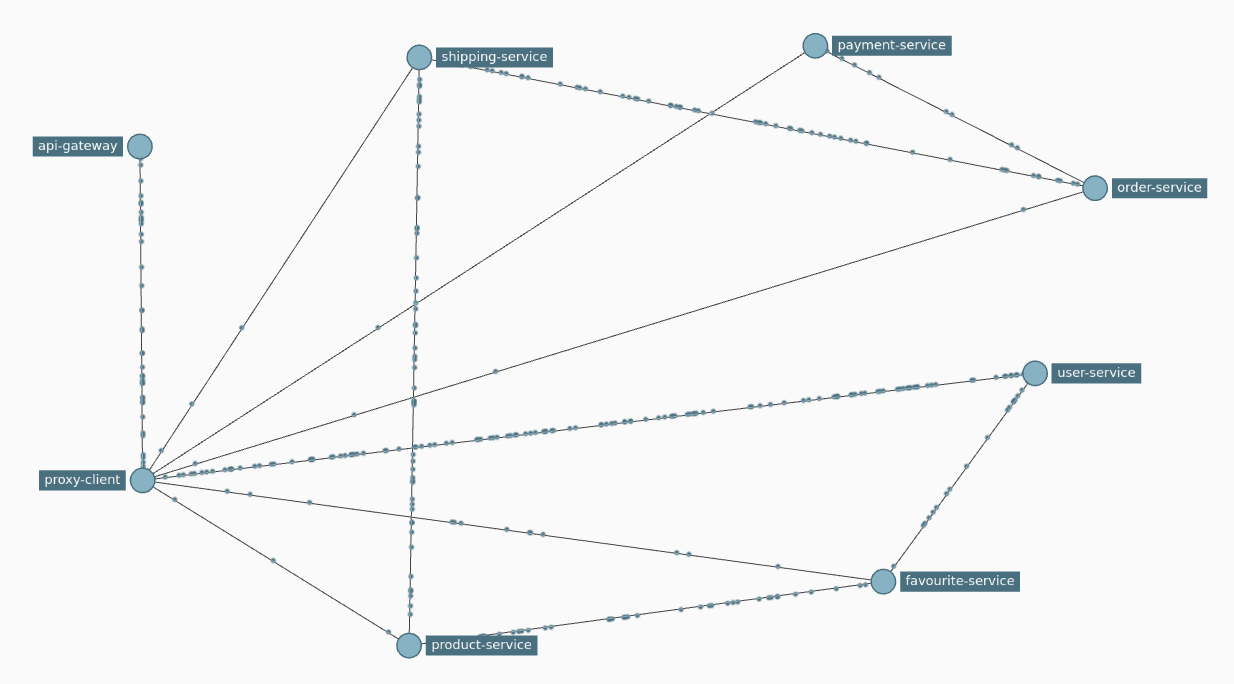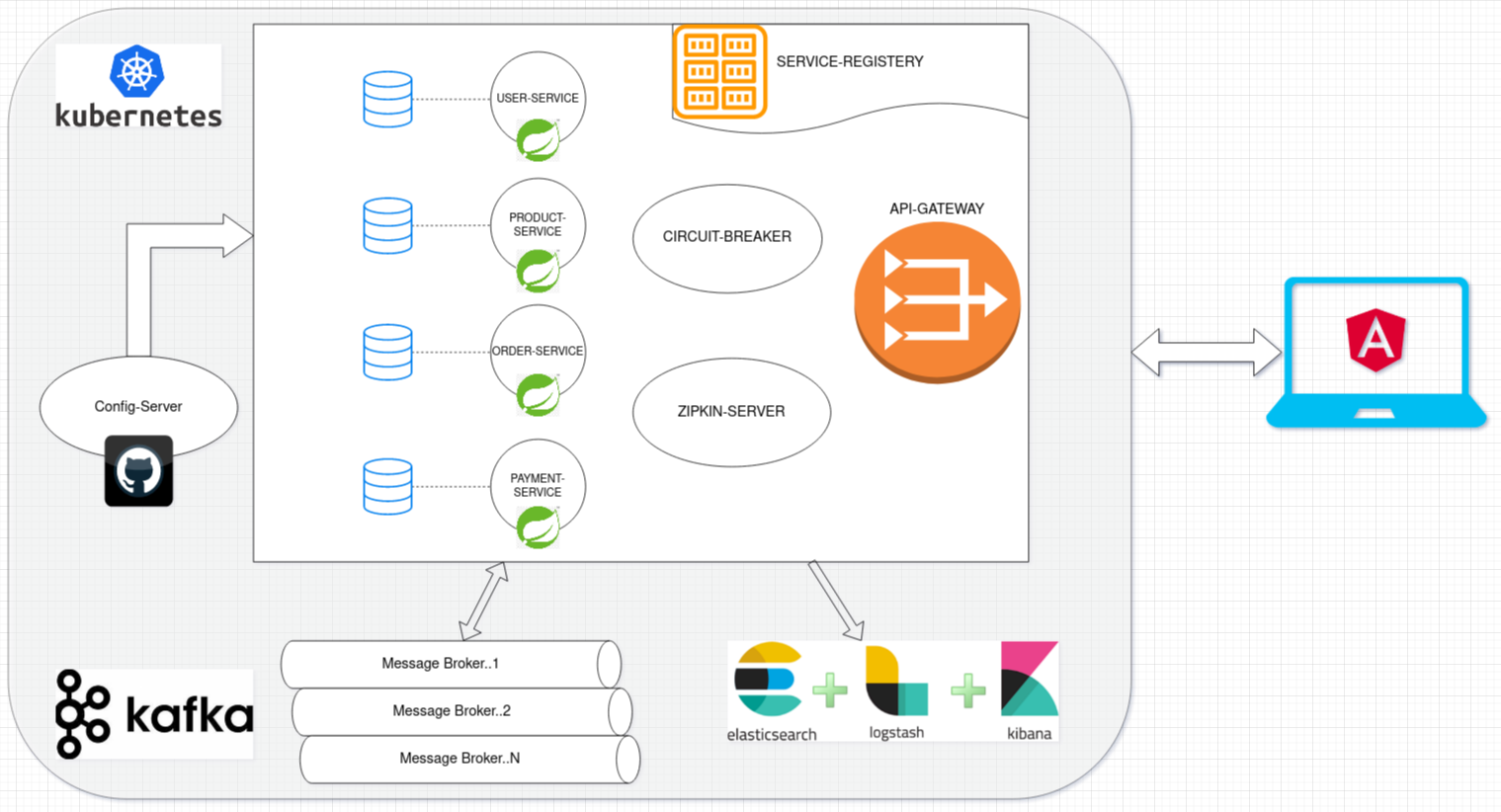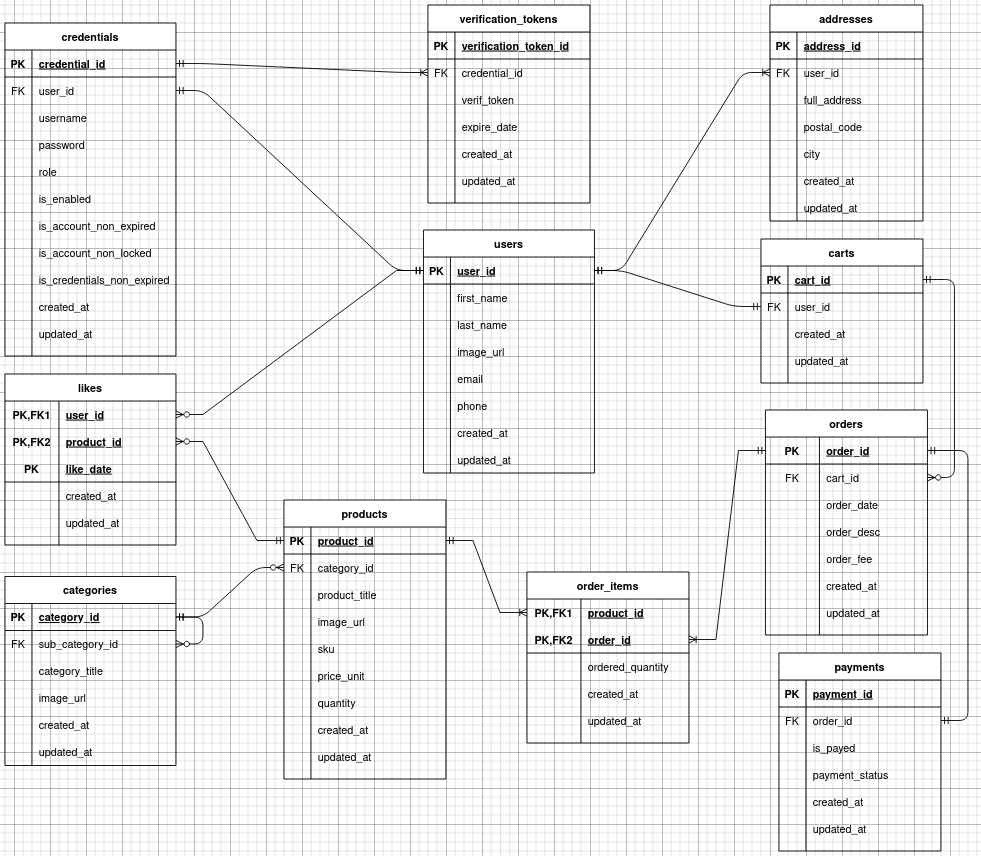Important Note: This project's new milestone is to move The whole system to work on Kubernetes, so stay tuned.
- This project is a development of a small set of Spring Boot and Cloud based Microservices projects that implement cloud-native intuitive, Reactive Programming, Event-driven, Microservices design patterns, and coding best practices.
- The project follows CloudNative recommendations and The twelve-factor app methodology for building software-as-a-service apps to show how μServices should be developed and deployed.
- This project uses cutting edge technologies like Docker, Kubernetes, Elasticsearch Stack for logging and monitoring, Java SE 11, H2, and MySQL databases, all components developed with TDD in mind, covering integration & performance testing, and many more.
- This project is going to be developed as stages, and all such stage steps are documented under the project e-Commerce-boot μServices README file .
Let's explain first the system structure to understand its components:
ecommerce-microservice-backend-app [μService] --> Parent folder.
|- docs --> All docs and diagrams.
|- k8s --> All **Kubernetes** config files.
|- proxy-client --> Authentication & Authorization µService, exposing all
|- api-gateway --> API Gateway server
|- service-discovery --> Service Registery server
|- cloud-config --> Centralized Configuration server
|- user-service --> Manage app users (customers & admins) as well as their credentials
|- product-service --> Manage app products and their respective categories
|- favourite-service --> Manage app users' favourite products added to their own favourite list
|- order-service --> Manage app orders based on carts
|- shipping-service --> Manage app order-shipping products
|- payment-service --> Manage app order payments
|- compose.yml --> contains all services landscape with Kafka
|- run-em-all.sh --> Run all microservices in separate mode.
|- setup.sh --> Install all shared POMs and shared libraries.
|- stop-em-all.sh --> Stop all services runs in standalone mode.
|- test-em-all.sh --> This will start all docker compose landscape and test them, then shutdown docker compose containers with test finishes (use switch start stop)
Now, as we have learned about different system components, then let's start.
The following are the initially required software pieces:
-
Java 11: JDK 11 LTS can be downloaded and installed from https://www.oracle.com/java/technologies/javase/jdk11-archive-downloads.html
-
Git: it can be downloaded and installed from https://git-scm.com/downloads
-
Maven: Apache Maven is a software project management and comprehension tool, it can be downloaded from here https://maven.apache.org/download.cgi
-
curl: this command-line tool for testing HTTP-based APIs can be downloaded and installed from https://curl.haxx.se/download.html
-
jq: This command-line JSON processor can be downloaded and installed from https://stedolan.github.io/jq/download/
-
Spring Boot Initializer: This Initializer generates spring boot project with just what you need to start quickly! Start from here https://start.spring.io/
-
Docker: The fastest way to containerize applications on your desktop, and you can download it from here https://www.docker.com/products/docker-desktop
-
Kubernetes: We can install minikube for testing puposes https://minikube.sigs.k8s.io/docs/start/
For each future stage, I will list the newly required software.
Follow the installation guide for each software website link and check your software versions from the command line to verify that they are all installed correctly.
I recommend that you work with your Java code using an IDE that supports the development of Spring Boot applications such as Spring Tool Suite or IntelliJ IDEA Ultimate Edition. So you can use the Spring Boot Dashboard to run the services, run each microservice test case, and many more.
All that you want to do is just fire up your IDE -> open or import the parent folder ecommerce-microservice-backend-app, and everything will be ready for you.
The first thing to do is to open git bash command line, and then simply you can clone the project under any of your favorite places as the following:
> git clone https://github.com/SelimHorri/ecommerce-microservice-backend-app.gitTo build and run the test cases for each service & shared modules in the project, we need to do the following:
Now it is the time to build our 10 microservices and run each service integration test in isolation by running the following commands:
selim@:~/ecommerce-microservice-backend-app$ ./mvnw clean package All build commands and test suite for each microservice should run successfully, and the final output should be like this:
---------------< com.selimhorri.app:ecommerce-microservice-backend >-----------
[INFO] ------------------------------------------------------------------------
[INFO] Reactor Summary for ecommerce-microservice-backend 0.1.0:
[INFO]
[INFO] ecommerce-microservice-backend ..................... SUCCESS [ 0.548 s]
[INFO] service-discovery .................................. SUCCESS [ 3.126 s]
[INFO] cloud-config ....................................... SUCCESS [ 1.595 s]
[INFO] api-gateway ........................................ SUCCESS [ 1.697 s]
[INFO] proxy-client ....................................... SUCCESS [ 3.632 s]
[INFO] user-service ....................................... SUCCESS [ 2.546 s]
[INFO] product-service .................................... SUCCESS [ 2.214 s]
[INFO] favourite-service .................................. SUCCESS [ 2.072 s]
[INFO] order-service ...................................... SUCCESS [ 2.241 s]
[INFO] shipping-service ................................... SUCCESS [ 2.197 s]
[INFO] payment-service .................................... SUCCESS [ 2.006 s]
[INFO] ------------------------------------------------------------------------
[INFO] BUILD SUCCESS
[INFO] ------------------------------------------------------------------------
[INFO] Total time: 24.156 s
[INFO] Finished at: 2021-12-29T19:52:57+01:00
[INFO] ------------------------------------------------------------------------Now it's the time to run all of our Microservices, and it's straightforward just run the following docker-compose commands:
selim@:~/ecommerce-microservice-backend-app$ docker-compose -f compose.yml upAll the services, databases, and messaging service will run in parallel in detach mode (option -d), and command output will print to the console the following:
Creating network "ecommerce-microservice-backend-app_default" with the default driver
Creating ecommerce-microservice-backend-app_api-gateway-container_1 ... done
Creating ecommerce-microservice-backend-app_favourite-service-container_1 ... done
Creating ecommerce-microservice-backend-app_service-discovery-container_1 ... done
Creating ecommerce-microservice-backend-app_shipping-service-container_1 ... done
Creating ecommerce-microservice-backend-app_order-service-container_1 ... done
Creating ecommerce-microservice-backend-app_user-service-container_1 ... done
Creating ecommerce-microservice-backend-app_payment-service-container_1 ... done
Creating ecommerce-microservice-backend-app_product-service-container_1 ... done
Creating ecommerce-microservice-backend-app_proxy-client-container_1 ... done
Creating ecommerce-microservice-backend-app_zipkin-container_1 ... done
Creating ecommerce-microservice-backend-app_cloud-config-container_1 ... doneYou can manually test proxy-client APIs throughout its Swagger interface at the following
URL https://localhost:8900/swagger-ui.html.
If you would like to access the Eureka service discovery point to this URL http://localhosts:8761/eureka to see all the services registered inside it.
URL https://localhost:8700/swagger-ui.html.
The API Gateway and Store Service both act as a resource server.
Check all Spring Boot Actuator exposed metrics http://localhost:8080/app/actuator/metrics:
{
"names": [
"http.server.requests",
"jvm.buffer.count",
"jvm.buffer.memory.used",
"jvm.buffer.total.capacity",
"jvm.classes.loaded",
"jvm.classes.unloaded",
"jvm.gc.live.data.size",
"jvm.gc.max.data.size",
"jvm.gc.memory.allocated",
"jvm.gc.memory.promoted",
"jvm.gc.pause",
"jvm.memory.committed",
"jvm.memory.max",
"jvm.memory.used",
"jvm.threads.daemon",
"jvm.threads.live",
"jvm.threads.peak",
"jvm.threads.states",
"logback.events",
"process.cpu.usage",
"process.files.max",
"process.files.open",
"process.start.time",
"process.uptime",
"resilience4j.circuitbreaker.buffered.calls",
"resilience4j.circuitbreaker.calls",
"resilience4j.circuitbreaker.failure.rate",
"resilience4j.circuitbreaker.not.permitted.calls",
"resilience4j.circuitbreaker.slow.call.rate",
"resilience4j.circuitbreaker.slow.calls",
"resilience4j.circuitbreaker.state",
"system.cpu.count",
"system.cpu.usage",
"system.load.average.1m",
"tomcat.sessions.active.current",
"tomcat.sessions.active.max",
"tomcat.sessions.alive.max",
"tomcat.sessions.created",
"tomcat.sessions.expired",
"tomcat.sessions.rejected",
"zipkin.reporter.messages",
"zipkin.reporter.messages.dropped",
"zipkin.reporter.messages.total",
"zipkin.reporter.queue.bytes",
"zipkin.reporter.queue.spans",
"zipkin.reporter.spans",
"zipkin.reporter.spans.dropped",
"zipkin.reporter.spans.total"
]
}Prometheus exposed metrics at http://localhost:8080/app/actuator/prometheus
# HELP resilience4j_circuitbreaker_not_permitted_calls_total Total number of not permitted calls
# TYPE resilience4j_circuitbreaker_not_permitted_calls_total counter
resilience4j_circuitbreaker_not_permitted_calls_total{kind="not_permitted",name="proxyService",} 0.0
# HELP jvm_gc_live_data_size_bytes Size of long-lived heap memory pool after reclamation
# TYPE jvm_gc_live_data_size_bytes gauge
jvm_gc_live_data_size_bytes 3721880.0
# HELP jvm_gc_pause_seconds Time spent in GC pause
# TYPE jvm_gc_pause_seconds summary
jvm_gc_pause_seconds_count{action="end of minor GC",cause="Metadata GC Threshold",} 1.0
jvm_gc_pause_seconds_sum{action="end of minor GC",cause="Metadata GC Threshold",} 0.071
jvm_gc_pause_seconds_count{action="end of minor GC",cause="G1 Evacuation Pause",} 6.0
jvm_gc_pause_seconds_sum{action="end of minor GC",cause="G1 Evacuation Pause",} 0.551
# HELP jvm_gc_pause_seconds_max Time spent in GC pause
# TYPE jvm_gc_pause_seconds_max gauge
jvm_gc_pause_seconds_max{action="end of minor GC",cause="Metadata GC Threshold",} 0.071
jvm_gc_pause_seconds_max{action="end of minor GC",cause="G1 Evacuation Pause",} 0.136
# HELP system_cpu_usage The "recent cpu usage" for the whole system
# TYPE system_cpu_usage gauge
system_cpu_usage 0.4069206655413552
# HELP jvm_buffer_total_capacity_bytes An estimate of the total capacity of the buffers in this pool
# TYPE jvm_buffer_total_capacity_bytes gauge
jvm_buffer_total_capacity_bytes{id="mapped",} 0.0
jvm_buffer_total_capacity_bytes{id="direct",} 24576.0
# HELP zipkin_reporter_spans_dropped_total Spans dropped (failed to report)
# TYPE zipkin_reporter_spans_dropped_total counter
zipkin_reporter_spans_dropped_total 4.0
# HELP zipkin_reporter_spans_bytes_total Total bytes of encoded spans reported
# TYPE zipkin_reporter_spans_bytes_total counter
zipkin_reporter_spans_bytes_total 1681.0
# HELP tomcat_sessions_active_current_sessions
# TYPE tomcat_sessions_active_current_sessions gauge
tomcat_sessions_active_current_sessions 0.0
# HELP jvm_classes_loaded_classes The number of classes that are currently loaded in the Java virtual machine
# TYPE jvm_classes_loaded_classes gauge
jvm_classes_loaded_classes 13714.0
# HELP process_files_open_files The open file descriptor count
# TYPE process_files_open_files gauge
process_files_open_files 17.0
# HELP resilience4j_circuitbreaker_slow_call_rate The slow call of the circuit breaker
# TYPE resilience4j_circuitbreaker_slow_call_rate gauge
resilience4j_circuitbreaker_slow_call_rate{name="proxyService",} -1.0
# HELP system_cpu_count The number of processors available to the Java virtual machine
# TYPE system_cpu_count gauge
system_cpu_count 8.0
# HELP jvm_threads_daemon_threads The current number of live daemon threads
# TYPE jvm_threads_daemon_threads gauge
jvm_threads_daemon_threads 21.0
# HELP zipkin_reporter_messages_total Messages reported (or attempted to be reported)
# TYPE zipkin_reporter_messages_total counter
zipkin_reporter_messages_total 2.0
# HELP zipkin_reporter_messages_dropped_total
# TYPE zipkin_reporter_messages_dropped_total counter
zipkin_reporter_messages_dropped_total{cause="ResourceAccessException",} 2.0
# HELP zipkin_reporter_messages_bytes_total Total bytes of messages reported
# TYPE zipkin_reporter_messages_bytes_total counter
zipkin_reporter_messages_bytes_total 1368.0
# HELP http_server_requests_seconds
# TYPE http_server_requests_seconds summary
http_server_requests_seconds_count{exception="None",method="GET",outcome="SUCCESS",status="200",uri="/actuator/metrics",} 1.0
http_server_requests_seconds_sum{exception="None",method="GET",outcome="SUCCESS",status="200",uri="/actuator/metrics",} 1.339804427
http_server_requests_seconds_count{exception="None",method="GET",outcome="SUCCESS",status="200",uri="/actuator/prometheus",} 1.0
http_server_requests_seconds_sum{exception="None",method="GET",outcome="SUCCESS",status="200",uri="/actuator/prometheus",} 0.053689381
# HELP http_server_requests_seconds_max
# TYPE http_server_requests_seconds_max gauge
http_server_requests_seconds_max{exception="None",method="GET",outcome="SUCCESS",status="200",uri="/actuator/metrics",} 1.339804427
http_server_requests_seconds_max{exception="None",method="GET",outcome="SUCCESS",status="200",uri="/actuator/prometheus",} 0.053689381
# HELP resilience4j_circuitbreaker_slow_calls The number of slow successful which were slower than a certain threshold
# TYPE resilience4j_circuitbreaker_slow_calls gauge
resilience4j_circuitbreaker_slow_calls{kind="successful",name="proxyService",} 0.0
resilience4j_circuitbreaker_slow_calls{kind="failed",name="proxyService",} 0.0
# HELP jvm_classes_unloaded_classes_total The total number of classes unloaded since the Java virtual machine has started execution
# TYPE jvm_classes_unloaded_classes_total counter
jvm_classes_unloaded_classes_total 0.0
# HELP process_files_max_files The maximum file descriptor count
# TYPE process_files_max_files gauge
process_files_max_files 1048576.0
# HELP resilience4j_circuitbreaker_calls_seconds Total number of successful calls
# TYPE resilience4j_circuitbreaker_calls_seconds summary
resilience4j_circuitbreaker_calls_seconds_count{kind="successful",name="proxyService",} 0.0
resilience4j_circuitbreaker_calls_seconds_sum{kind="successful",name="proxyService",} 0.0
resilience4j_circuitbreaker_calls_seconds_count{kind="failed",name="proxyService",} 0.0
resilience4j_circuitbreaker_calls_seconds_sum{kind="failed",name="proxyService",} 0.0
resilience4j_circuitbreaker_calls_seconds_count{kind="ignored",name="proxyService",} 0.0
resilience4j_circuitbreaker_calls_seconds_sum{kind="ignored",name="proxyService",} 0.0
# HELP resilience4j_circuitbreaker_calls_seconds_max Total number of successful calls
# TYPE resilience4j_circuitbreaker_calls_seconds_max gauge
resilience4j_circuitbreaker_calls_seconds_max{kind="successful",name="proxyService",} 0.0
resilience4j_circuitbreaker_calls_seconds_max{kind="failed",name="proxyService",} 0.0
resilience4j_circuitbreaker_calls_seconds_max{kind="ignored",name="proxyService",} 0.0
# HELP zipkin_reporter_spans_total Spans reported
# TYPE zipkin_reporter_spans_total counter
zipkin_reporter_spans_total 5.0
# HELP zipkin_reporter_queue_bytes Total size of all encoded spans queued for reporting
# TYPE zipkin_reporter_queue_bytes gauge
zipkin_reporter_queue_bytes 0.0
# HELP tomcat_sessions_expired_sessions_total
# TYPE tomcat_sessions_expired_sessions_total counter
tomcat_sessions_expired_sessions_total 0.0
# HELP tomcat_sessions_alive_max_seconds
# TYPE tomcat_sessions_alive_max_seconds gauge
tomcat_sessions_alive_max_seconds 0.0
# HELP process_uptime_seconds The uptime of the Java virtual machine
# TYPE process_uptime_seconds gauge
process_uptime_seconds 224.402
# HELP tomcat_sessions_active_max_sessions
# TYPE tomcat_sessions_active_max_sessions gauge
tomcat_sessions_active_max_sessions 0.0
# HELP process_cpu_usage The "recent cpu usage" for the Java Virtual Machine process
# TYPE process_cpu_usage gauge
process_cpu_usage 5.625879043600563E-4
# HELP jvm_gc_memory_promoted_bytes_total Count of positive increases in the size of the old generation memory pool before GC to after GC
# TYPE jvm_gc_memory_promoted_bytes_total counter
jvm_gc_memory_promoted_bytes_total 1.7851088E7
# HELP logback_events_total Number of error level events that made it to the logs
# TYPE logback_events_total counter
logback_events_total{level="warn",} 5.0
logback_events_total{level="debug",} 79.0
logback_events_total{level="error",} 0.0
logback_events_total{level="trace",} 0.0
logback_events_total{level="info",} 60.0
# HELP tomcat_sessions_created_sessions_total
# TYPE tomcat_sessions_created_sessions_total counter
tomcat_sessions_created_sessions_total 0.0
# HELP jvm_threads_live_threads The current number of live threads including both daemon and non-daemon threads
# TYPE jvm_threads_live_threads gauge
jvm_threads_live_threads 25.0
# HELP jvm_threads_states_threads The current number of threads having NEW state
# TYPE jvm_threads_states_threads gauge
jvm_threads_states_threads{state="runnable",} 6.0
jvm_threads_states_threads{state="blocked",} 0.0
jvm_threads_states_threads{state="waiting",} 8.0
jvm_threads_states_threads{state="timed-waiting",} 11.0
jvm_threads_states_threads{state="new",} 0.0
jvm_threads_states_threads{state="terminated",} 0.0
# HELP tomcat_sessions_rejected_sessions_total
# TYPE tomcat_sessions_rejected_sessions_total counter
tomcat_sessions_rejected_sessions_total 0.0
# HELP process_start_time_seconds Start time of the process since unix epoch.
# TYPE process_start_time_seconds gauge
process_start_time_seconds 1.64088634006E9
# HELP resilience4j_circuitbreaker_buffered_calls The number of buffered failed calls stored in the ring buffer
# TYPE resilience4j_circuitbreaker_buffered_calls gauge
resilience4j_circuitbreaker_buffered_calls{kind="successful",name="proxyService",} 0.0
resilience4j_circuitbreaker_buffered_calls{kind="failed",name="proxyService",} 0.0
# HELP jvm_memory_max_bytes The maximum amount of memory in bytes that can be used for memory management
# TYPE jvm_memory_max_bytes gauge
jvm_memory_max_bytes{area="nonheap",id="CodeHeap 'profiled nmethods'",} 1.22908672E8
jvm_memory_max_bytes{area="heap",id="G1 Survivor Space",} -1.0
jvm_memory_max_bytes{area="heap",id="G1 Old Gen",} 5.182062592E9
jvm_memory_max_bytes{area="nonheap",id="Metaspace",} -1.0
jvm_memory_max_bytes{area="nonheap",id="CodeHeap 'non-nmethods'",} 5836800.0
jvm_memory_max_bytes{area="heap",id="G1 Eden Space",} -1.0
jvm_memory_max_bytes{area="nonheap",id="Compressed Class Space",} 1.073741824E9
jvm_memory_max_bytes{area="nonheap",id="CodeHeap 'non-profiled nmethods'",} 1.22912768E8
# HELP jvm_memory_committed_bytes The amount of memory in bytes that is committed for the Java virtual machine to use
# TYPE jvm_memory_committed_bytes gauge
jvm_memory_committed_bytes{area="nonheap",id="CodeHeap 'profiled nmethods'",} 1.6646144E7
jvm_memory_committed_bytes{area="heap",id="G1 Survivor Space",} 2.4117248E7
jvm_memory_committed_bytes{area="heap",id="G1 Old Gen",} 1.7301504E8
jvm_memory_committed_bytes{area="nonheap",id="Metaspace",} 7.6857344E7
jvm_memory_committed_bytes{area="nonheap",id="CodeHeap 'non-nmethods'",} 2555904.0
jvm_memory_committed_bytes{area="heap",id="G1 Eden Space",} 2.71581184E8
jvm_memory_committed_bytes{area="nonheap",id="Compressed Class Space",} 1.0354688E7
jvm_memory_committed_bytes{area="nonheap",id="CodeHeap 'non-profiled nmethods'",} 6619136.0
# HELP jvm_memory_used_bytes The amount of used memory
# TYPE jvm_memory_used_bytes gauge
jvm_memory_used_bytes{area="nonheap",id="CodeHeap 'profiled nmethods'",} 1.6585088E7
jvm_memory_used_bytes{area="heap",id="G1 Survivor Space",} 2.4117248E7
jvm_memory_used_bytes{area="heap",id="G1 Old Gen",} 2.0524392E7
jvm_memory_used_bytes{area="nonheap",id="Metaspace",} 7.4384552E7
jvm_memory_used_bytes{area="nonheap",id="CodeHeap 'non-nmethods'",} 1261696.0
jvm_memory_used_bytes{area="heap",id="G1 Eden Space",} 2.5165824E7
jvm_memory_used_bytes{area="nonheap",id="Compressed Class Space",} 9365664.0
jvm_memory_used_bytes{area="nonheap",id="CodeHeap 'non-profiled nmethods'",} 6604416.0
# HELP system_load_average_1m The sum of the number of runnable entities queued to available processors and the number of runnable entities running on the available processors averaged over a period of time
# TYPE system_load_average_1m gauge
system_load_average_1m 8.68
# HELP resilience4j_circuitbreaker_state The states of the circuit breaker
# TYPE resilience4j_circuitbreaker_state gauge
resilience4j_circuitbreaker_state{name="proxyService",state="forced_open",} 0.0
resilience4j_circuitbreaker_state{name="proxyService",state="closed",} 1.0
resilience4j_circuitbreaker_state{name="proxyService",state="disabled",} 0.0
resilience4j_circuitbreaker_state{name="proxyService",state="open",} 0.0
resilience4j_circuitbreaker_state{name="proxyService",state="half_open",} 0.0
resilience4j_circuitbreaker_state{name="proxyService",state="metrics_only",} 0.0
# HELP jvm_buffer_memory_used_bytes An estimate of the memory that the Java virtual machine is using for this buffer pool
# TYPE jvm_buffer_memory_used_bytes gauge
jvm_buffer_memory_used_bytes{id="mapped",} 0.0
jvm_buffer_memory_used_bytes{id="direct",} 24576.0
# HELP resilience4j_circuitbreaker_failure_rate The failure rate of the circuit breaker
# TYPE resilience4j_circuitbreaker_failure_rate gauge
resilience4j_circuitbreaker_failure_rate{name="proxyService",} -1.0
# HELP zipkin_reporter_queue_spans Spans queued for reporting
# TYPE zipkin_reporter_queue_spans gauge
zipkin_reporter_queue_spans 0.0
# HELP jvm_gc_memory_allocated_bytes_total Incremented for an increase in the size of the (young) heap memory pool after one GC to before the next
# TYPE jvm_gc_memory_allocated_bytes_total counter
jvm_gc_memory_allocated_bytes_total 1.402994688E9
# HELP jvm_buffer_count_buffers An estimate of the number of buffers in the pool
# TYPE jvm_buffer_count_buffers gauge
jvm_buffer_count_buffers{id="mapped",} 0.0
jvm_buffer_count_buffers{id="direct",} 3.0
# HELP jvm_threads_peak_threads The peak live thread count since the Java virtual machine started or peak was reset
# TYPE jvm_threads_peak_threads gauge
jvm_threads_peak_threads 25.0
# HELP jvm_gc_max_data_size_bytes Max size of long-lived heap memory pool
# TYPE jvm_gc_max_data_size_bytes gauge
jvm_gc_max_data_size_bytes 5.182062592E9From ecommerce front Service proxy we can check all the core services health when you have all the microservices up and running using Docker Compose,
selim@:~/ecommerce-microservice-backend-app$ curl -k https://localhost:8443/actuator/health -s | jq .components."\"Core Microservices\""This will result in the following response:
{
"status": "UP",
"components": {
"circuitBreakers": {
"status": "UP",
"details": {
"proxyService": {
"status": "UP",
"details": {
"failureRate": "-1.0%",
"failureRateThreshold": "50.0%",
"slowCallRate": "-1.0%",
"slowCallRateThreshold": "100.0%",
"bufferedCalls": 0,
"slowCalls": 0,
"slowFailedCalls": 0,
"failedCalls": 0,
"notPermittedCalls": 0,
"state": "CLOSED"
}
}
}
},
"clientConfigServer": {
"status": "UNKNOWN",
"details": {
"error": "no property sources located"
}
},
"discoveryComposite": {
"status": "UP",
"components": {
"discoveryClient": {
"status": "UP",
"details": {
"services": [
"proxy-client",
"api-gateway",
"cloud-config",
"product-service",
"user-service",
"favourite-service",
"order-service",
"payment-service",
"shipping-service"
]
}
},
"eureka": {
"description": "Remote status from Eureka server",
"status": "UP",
"details": {
"applications": {
"FAVOURITE-SERVICE": 1,
"PROXY-CLIENT": 1,
"API-GATEWAY": 1,
"PAYMENT-SERVICE": 1,
"ORDER-SERVICE": 1,
"CLOUD-CONFIG": 1,
"PRODUCT-SERVICE": 1,
"SHIPPING-SERVICE": 1,
"USER-SERVICE": 1
}
}
}
}
},
"diskSpace": {
"status": "UP",
"details": {
"total": 981889826816,
"free": 325116776448,
"threshold": 10485760,
"exists": true
}
},
"ping": {
"status": "UP"
},
"refreshScope": {
"status": "UP"
}
}
}Now it's time to test all the application functionality as one part. To do so just run the following automation test script:
selim@:~/ecommerce-microservice-backend-app$ ./test-em-all.sh startYou can use
stopswitch withstart, that will
- start docker,
- run the tests,
- stop the docker instances.
The result will look like this:
Starting 'ecommerce-microservice-backend-app' for [Blackbox] testing...
Start Tests: Tue, May 31, 2020 2:09:36 AM
HOST=localhost
PORT=8080
Restarting the test environment...
$ docker-compose -p -f compose.yml down --remove-orphans
$ docker-compose -p -f compose.yml up -d
Wait for: curl -k https://localhost:8080/actuator/health... , retry #1 , retry #2, {"status":"UP"} DONE, continues...
Test OK (HTTP Code: 200)
...
Test OK (actual value: 1)
Test OK (actual value: 3)
Test OK (actual value: 3)
Test OK (HTTP Code: 404, {"httpStatus":"NOT_FOUND","message":"No product found for productId: 13","path":"/app/api/products/20","time":"2020-04-12@12:34:25.144+0000"})
...
Test OK (actual value: 3)
Test OK (actual value: 0)
Test OK (HTTP Code: 422, {"httpStatus":"UNPROCESSABLE_ENTITY","message":"Invalid productId: -1","path":"/app/api/products/-1","time":"2020-04-12@12:34:26.243+0000"})
Test OK (actual value: "Invalid productId: -1")
Test OK (HTTP Code: 400, {"timestamp":"2020-04-12T12:34:26.471+00:00","path":"/app/api/products/invalidProductId","status":400,"error":"Bad Request","message":"Type mismatch.","requestId":"044dcdf2-13"})
Test OK (actual value: "Type mismatch.")
Test OK (HTTP Code: 401, )
Test OK (HTTP Code: 200)
Test OK (HTTP Code: 403, )
Start Circuit Breaker tests!
Test OK (actual value: CLOSED)
Test OK (HTTP Code: 500, {"timestamp":"2020-05-26T00:09:48.784+00:00","path":"/app/api/products/2","status":500,"error":"Internal Server Error","message":"Did not observe any item or terminal signal within 2000ms in 'onErrorResume' (and no fallback has been configured)","requestId":"4aa9f5e8-119"})
...
Test OK (actual value: Did not observe any item or terminal signal within 2000ms)
Test OK (HTTP Code: 200)
Test OK (actual value: Fallback product2)
Test OK (HTTP Code: 200)
Test OK (actual value: Fallback product2)
Test OK (HTTP Code: 404, {"httpStatus":"NOT_FOUND","message":"Product Id: 14 not found in fallback cache!","path":"/app/api/products/14","timestamp":"2020-05-26@00:09:53.998+0000"})
...
Test OK (actual value: product name C)
Test OK (actual value: CLOSED)
Test OK (actual value: CLOSED_TO_OPEN)
Test OK (actual value: OPEN_TO_HALF_OPEN)
Test OK (actual value: HALF_OPEN_TO_CLOSED)
End, all tests OK: Tue, May 31, 2020 2:10:09 AMNow, you can now track Microservices interactions throughout Zipkin UI from the following link:
http://localhost:9411/zipkin/

Finally, to close the story, we need to shut down Microservices manually service by service, hahaha just kidding, run the following command to shut them all:
selim@:~/ecommerce-microservice-backend-app$ docker-compose -f compose.yml down --remove-orphansAnd you should see output like the following:
Removing ecommerce-microservice-backend-app_payment-service-container_1 ... done
Removing ecommerce-microservice-backend-app_zipkin-container_1 ... done
Removing ecommerce-microservice-backend-app_service-discovery-container_1 ... done
Removing ecommerce-microservice-backend-app_product-service-container_1 ... done
Removing ecommerce-microservice-backend-app_cloud-config-container_1 ... done
Removing ecommerce-microservice-backend-app_proxy-client-container_1 ... done
Removing ecommerce-microservice-backend-app_order-service-container_1 ... done
Removing ecommerce-microservice-backend-app_user-service-container_1 ... done
Removing ecommerce-microservice-backend-app_shipping-service-container_1 ... done
Removing ecommerce-microservice-backend-app_api-gateway-container_1 ... done
Removing ecommerce-microservice-backend-app_favourite-service-container_1 ... done
Removing network ecommerce-microservice-backend-app_defaultIn the end, I hope you enjoyed the application and find it useful, as I did when I was developing it. If you would like to enhance, please:
- Open PRs,
- Give feedback,
- Add new suggestions, and
- Finally, give it a 🌟.
Happy Coding ... 🙂

